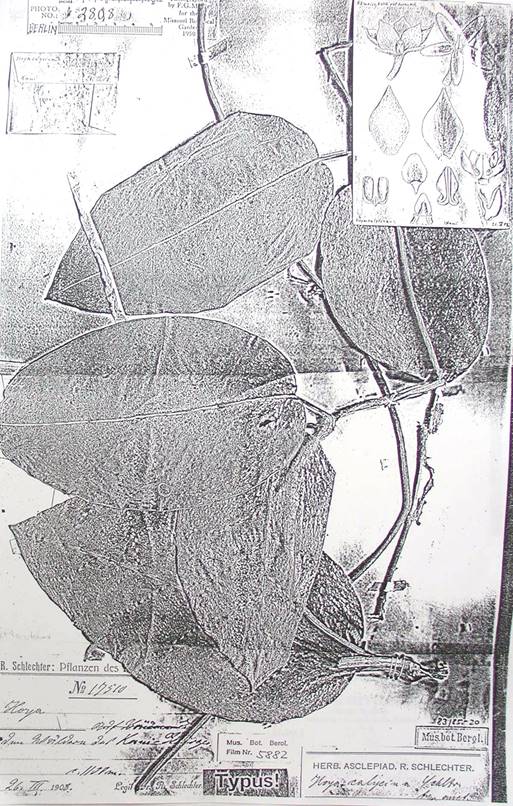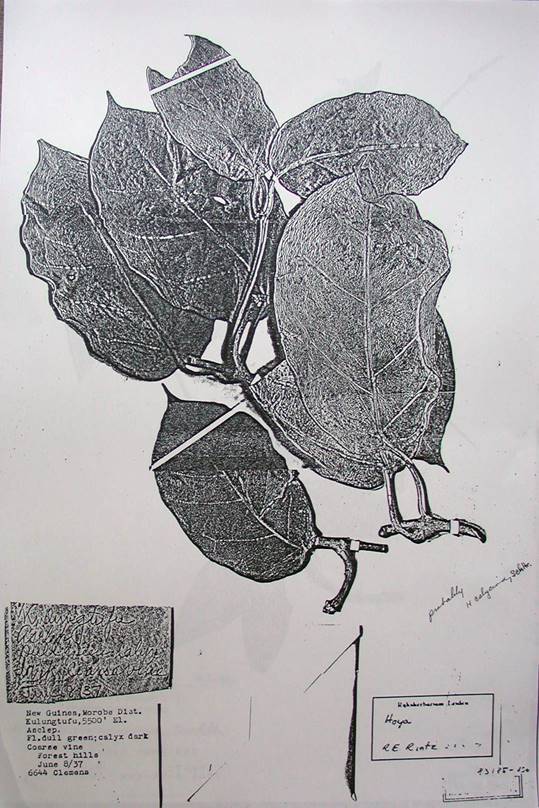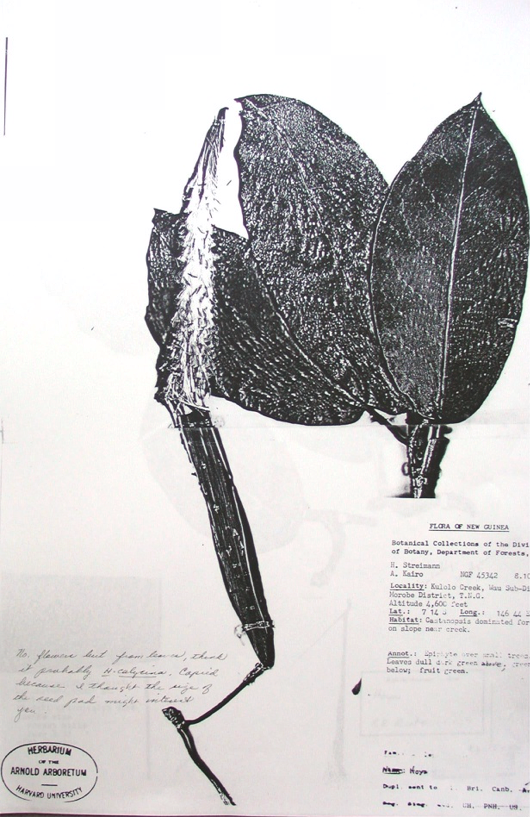
Hoya calycina Schlechter 1908
Type description:
In Botanische Jahrbücher 50 (1913) 125. “Die Asclepiadaceen von Deutsch Neu Guinea” R. Schlechter. 32. H. calycina Schltr. n. sp. - Suffrutex parum ramosus, alte scandens. Rami filiformes, flexuosi, elongati, lax foliati, teretes, brevissime et molliter tomentosuli. Folia patentia vel patula, petiolata, late ovalia, apiculata, basi subcordata, coriacea, suprne sparsim puberula, subtus brevissime tomentosula, petiolo tomentosulo superne leviter sulcato. Inflorescentiae umbelliformes. c. 10-florae, pedunculo pedicellisque puberulis. Flores illis H. abiflorae Zipp. paulo minores. Calycis foliola oblonga, obtusa, extus puberula, margine minute ciliata, quam corolla paulo breviora. Corolla subrotata, usque infra medium 5-fida, extus subinconspicucue sparsim puberula, intus glabra, lobis ovatis, acutis. Coronae foliola superne ovalia, apice rostrato-acuminata et dorso altius adscendentia, lateraliter paulo compressa, basi subtus carinato-marginata, apice antheris paulo breviora. Pollinia oblique oblongoidea, translatoribus perbrevibus applanatis, retinaculo parvulo rhomboideo.
Eine hochkletternde Liane mit schnurförmigen locker beblätterten Zweigen, Blätter 6 - 20 cm. lang, etwa in der Mitte 9 - 11 cm. breit, Blattstiel 3 - 3.5 cm. lang. Blütenstände etwa 4--blütig auf ca. 5 cm. langen Stiel. Blütenstiel fein und kurz behaart, ca. 2.5 cm. lang. Blüten kleiner als die der H. albiflora Zipp. Kelch für die Gattung auffallend grosz, Zipfel ca. 0.8 cm. lang. Korolla ausgebreitet etwa 2 cm. lang, vorn und hinten beinahe 4 mm. hoch. Nordöstl. Neu-Guinea: in den Nebelwäldern des Kan-Gebirges, ca. 4400 m ü. M. (Schlechter n. 17510. - Blühend im März 1908). Eine vorzüglich gekennzeichnete Art. welche unzweifelhaft in H. albiflora Zipp. ihre nächste Verwandte hat aber in den behaarten Blättern, den gröszeren Kelchblättern und den kleineren Blüten leicht zu unterscheiden ist. Leider ist mein Material nicht sehr reichlich, da die einzige gefindene Pflanze sich offfenbar schon dem Verblühen näherte und bei der geringsten Berührung die Blüten abwarf. Die Blütenfärbung ist weisz mit rotberandenten Kelchzipfeln.Translation: A subshrub with few branches, high climbing. Branches filiform, flexible, elongate, loosely leaved, round, very briefly and lightly tomentose. Leaves spread or outspread, petiolate, broadly oval, apiculate, with base somewhat cordate, leathery, above sparsely puberulous, below shortly tomentose, petiole tomentose above slightly grooved. Inflorescence like an umbel, about 10-flowered, peduncle and pedicels puberulous. Flowers like H. albiflora Zipp. somewhat smaller, leaflets of the calyx oblong, obtuse, outside puberulous, margines minutely ciliate, much smaller than the those of the corolla. Corolla somewhat rotate, 5-fid up to the middle, outside somewhat inconspicuously and sparsely puberulous, inside glabrous, lobes ovate, acute. Leaflets of the corona above oval tips beaked-acuminate and with the back ascending high, sides a little compressed, base below keel-margined, anther tips small, short. Pollinia oblique, oblong, translators rather short flattened, retinaculum small rhomboid.
A high climbing vine with filiform, loose, lax-leaved branches. Leaves 16 to 20 cm. long, it is in the middle 9 to 11 cm. wide. petiole 3 to 3.5 cm. long. Umbel with up to 10 blooms on pedicels about 5 cm. long. Pedicels slender with short hairs about 2.5 cm. long. Flowers smaller than those of Hoya albiflora Zipp. calyx for the genus is strikingly large, about 0.3 cm. long. Corolla outspread is about 2 cm. in diameter. Corona lobes from the tip to the other end are about 3 mm. long, and behind almost 4 mm. high.
Northeastern New Guinea in the depth of the forest of the Kani Mountains about 1100 meters altitude (Schlechter #17510. - Blooming in March 1908). A characteristic superior species which is undoubtedly closely allied to Hoya albiflora Zipp. but differing in the hairy leaves, the larger calyx lobes, and the smaller blooms. Unfortunately my material is not very complete, since the only plants I found were close to finishing blooming or dropped their flowers at the slightest touch. The flower color is white with a red bordered calyx.
In Hoyas of Northeastern New Guinea (1989) 66. R. D. Kloppenburg. 32. Hoya calycina Schlechter n. sp. A high climbing half-shrub, not much branched. Branches threadlike, flexible, elongated, loosely leaved, round, very shortly and minutely tomentose. Leaves spreading or outspread, petiolate, broadly oval, apiculate, somewhat cordate base, coriaceous (leathery), sparsely puberulous above, very shortly tomentose below, petiole tomentose, above slightly grooved. Inflorescences shaped like an umbel, about 10 flowered, pedicels of the peduncle puberulous. Flower like H. albiflora Zipp. (albiflora) a little smaller. Leaflets (lobes) of the calyx oblong, obtuse, puberulous outside, margins minutely ciliate, a little smaller than the corolla. Corolla somewhat rotate (subrotate), 5 parted all the way to the middle, outside somewhat inconspicuously sparsely puberulous, inside glabrous, lobes ovate, acute. Leaflets (scales) of the corona above oval, apex beaked-acuminate and back ascending high, sides a little compressed, margins keeled beneath base, anther apex a little shorter. Pollinia obliquely oblong, with the translators very small, flattened, retinaculum small, rhomboid.
A high climbing clinging vine with cord like loosely leaved branches. Leaves 16-20 cm. long, near the middle 9-11 cm. wide. Petiole 3-3.5 cm. long. Inflorescences of some 10 blooms on a peduncle about 5 cm. long. Petioles fine and with short hairs, about 2.5 cm. long. Flowers smaller than those of H. albiflora Zipp. Calyx for the genus strikingly large, to the apex about 0.8 cm. long Corolla spread out, nearly 2 cm. in diameter. Corona scales from the tip to the outer edge some 3 mm. long in front and in back almost 4 mm. high.
Northeastern New Guinea: in the fog forests of the Kani Mountains about 1100 m. altitude (Schlechter #17510 - Blooming in March 1908).
A prominently recognized species which undoubtedly has as its nearest relative H. albiflora Zipp. but is easily recognized by its pubescent leaves, the larger sepals and the smaller bloom. Unfortunately my material is not very extensive, since the only plant I found was close to blooming out and dropped its flowers at the slightest touch. The bloom color is white with red edged calyx lobes.
In Austrobalia 3(4) (1992) 631-632. “Taxonomic Studies on the Genus Hoya R. Br. (Asclepiadaceae) in Papuasia” P. I. Forster and D. J. Liddle 3. Hoya calycina Schltr., Bot. Jahrb. Syst. 50: 125 (1913). Type: Papua New Guinea. Madang Province: Kani Mountain., Mar 1908, R. Schlechter 17510 (holo: B (photo at BRI!)) [Hoya albiflora auct., non (Zipp. ex Blume) Boerl.: Burton, Hoyan 11(2): 57‑58 (1989)].
Liane to several meter’s long, latex white. Stems cylindrical, up to 6 mm diameter, glabrous or with scattered to dense indumentum when young, becoming corky with age; internodes up to 160 mm long. Leaves petiolate; lamina elliptic to elliptic‑ovate, up to 170 mm long and 90 mm wide; upper surface glabrous or with scattered indumentum, venation obscure; lower surface glabrous or with scattered to dense velutinous indumentum, venation obscure; tip acute, acuminate, or apiculate; base rounded, cuneate, or slightly cordate; petiole 12‑30 mm long, 1.5‑3.5 mm diameter, with scattered to dense indumentum; colleters 4 at lamina base. Cymes racemiform, up to 70 mm long; peduncles 6‑25 mm long, 3‑7 mm diameter, glabrous or with scattered to dense indumentum; bracts triangular to lanceolate, 0.8‑1.0 mm long, 0.5‑1.0 mm wide. Flowers 9‑10 mm long, 18‑28 mm diameter; pedicels 24‑44 mm long, 1.6‑2.0 mm diameter, glabrous or with scattered to dense indumentum. Sepals lanceolate to lanceolate‑ovate, 2.8‑5.0 mm long, L2‑3.0 mm wide, glabrous or with scattered to dense indumentum; base of each sinus with an irregular glandular ridge. Corolla campanulate‑rotate, cream to white, red to purple under coronal lobes and around gynostegium; tube 3.0‑5.4 mm long, 8‑14 mm diameter, glabrous; lobes lanceolate‑ovate, 7‑13 mm long, 4‑9 mm wide, glabrous or with scattered to sparse indumentum on the edges and externally. Staminal corona 4.0‑4.3 mm long, 7‑13 mm diameter; lobes 3.4‑4.8 mm long, 4.0‑4.3 mm high, 1.82.5 mm wide. Staminal column 3.6‑4.0 mm long, 2.5‑3.5 mm diameter, anther appendages lanceolate, 1.6‑2.0 mm long, 1.7‑1.8 mm wide; alar fissure 1.3‑2.0 mm long. Stylehead depressed‑globose, 1.5‑1.9 mm diameter. Ovaries 2.3‑2.4 mm long, 1.8‑1.9 mm wide, glabrous. Pollinarium c. 1.1 mm long, 0.85‑0.90 mm wide; pollinia oblong, 1.051.10 mm long, 0.35‑0.40 mm wide, with pellucid germination mouth on outer edge; corpusculum ovate, 0.60‑0.65 mm long, 0.35‑0.40 mm wide; caudicles unwinged, 0.250.30 mm long, 0.06‑0.07 mm wide. Fruit and seed not seen. Fig. 3.
Notes: H. calycina is a distinctive species that has been confused with H. australis and H. albiflora, mainly because of its superficially similar flowers. It differs most markedly from H. australis in the more‑or‑less internally glabrous corolla and the much larger staminal corona and from H. albiflora in the rotate corolla. Like H. australis, H. calycina is variable in terms of indumentum and two subspecies can be recognized on this character.
Key to subspecies of Hoya calycina
1. Lamina with dense velutinous indumentum below, calyx and corolla with sparse to dense indumentum externally .........………..……………………… subsp. calycina
Lamina glabrous or with scattered indumentum below, calyx and corolla glabrous or with scattered indumentum externally ...........................……………………. subsp. glabrifolia
3a. Hoya calycina subsp. calycina
Lamina with dense velutinous indumentum below. Calyx and corolla with sparse to dense indumentum externally.
Specimens examined. Papua New Guinea. New Ireland: Wanup near Lossuk, 2º45'S, 151º04'E, Jan 1967, Coode et al. NGF29625 (L). Morobe Province: S of Boana, 6º30'S, 146º50'E, Feb 1977, Conn et al. 86 (K,L); Patep Creek, 6º35'S, 146º25'E, May 1959, Millar NGF9967 (A,BRI,CANB,LAE); Zenag, 7º00'S, 146º35'E Jul 1968, Millar NGF12115 (A,BRI,CANB,L,LAE); Kwaimengu, Aseki Patrol Area, Apr 1966, Craven & Schodde 1459 (A,L,LAE). Southern Highlands Province: Mt. Bosavi, northern side, N of the Mission Station, 6º26'S, 142º50'E, Oct 1973, Jacobs 9496 (L,LAE) Northern Province. 2 km W of Popondetta along road near airstrip, Jul 1953, Hoogland 3379 (A,BM,BRI,CANB,K,L,LAE). Milne Bay Province: SW of Nowata airstrip, 9º59'S, 149º44'E, Jul 1969, Kanis 1104 (CANB,LAE). Cultivated. Emerald Creek, Mareeba (ex plant collected Morobe Province: Patep II Village, [USDA354236]), Apr 1990, Liddle IML 201 (BRI).
Distribution and habitat: Widespread in Papua New Guinea (Map 3). Plants grow in rainforest at altitudes of 20‑1400 m.
3b. Hoya calycina subsp. glabrifolia P. Forster & Liddle subsp. nov., a H. calycina Schltr. subsp. calycina lamina foliorum glabra vel infra pills dispersis praedita, calyce corollaque glabra vel extus pills non nisi sejunctis praedita differt. Typus: Irian Jaya. 4 km SW of Bernhard Camp, Idenburg River, Mar 1939, L.J. Brass 13465 (holo: BRI!; iso: A!, BO!, L!).
Lamina glabrous or with scattered indumentum below; calyx and corolla glabrous or with scattered indumentum externally.
Specimens examined. Papua New Guinea. Western Highlands Province Jimmi Valley, near Karap, Jun 1955, Womersley & Millar NGF7648 (BRI,LAE) Eastern Highlands Province: Kassam, Nov 1959, Brass 32470 (LAE). Morobe Province: Bupu Village, Wampit, 6~50'S, 146~55'E, Jul 1967, Millar NGF22936 (BRI,L,LAE). Central Province: Isuarava, 9°OO'S, 147º44'E, Mar 1936, Carr 16107 (BM,CANB,L,NY,SING; K n.v.).
Distribution and habitat: Widespread but rarely collected in Papua New Guinea (Map 4). Plants grow as lianes in rainforest at altitudes of 1500‑1900 m.
In Dr. Schlechter’s Hoya Species (1993) 44-45. R. D. Kloppenburg. Hoya calycina Schlechter n. sp.
A not much branched high climbing, half-shrub. Branches threadlike, flexible, elongated, loosely leaved, round, very shortly and minutely tomentose. Leaves spreading or outspread, petiolate, broadly oval, apiculate, somewhat cordate base, coriaceous (leathery), sparsely puberulous above, very shortly tomentose below, petiole tomentose, above slightly grooved. Inflorescence shaped like an umbel, about 10 flowered, pedicels of the peduncle puberulous. Flower like H. albiflorae Zipp. (albiflora) a little smaller. Lobes of the calyx oblong, obtuse, puberulous outside, margins minutely ciliate, a little smaller than the corolla. Corolla somewhat rotate, 5 parted all the way to the middle, outside somewhat inconspicuously sparsely puberulous, inside glabrous, lobes ovate, acute. Scales of the corona above oval, apex beaked-acuminate and back ascending high, sides a little compressed, margins keeled beneath base, anther apex a little shorter. Pollinia obliquely oblong, with the translators very small, flattened, retinaculum small, rhomboid.
A high climbing clinging vine with cord like loosely leaved branches. Leaves 16-20 cm. long, near the middle 9-11 cm. wide. Petiole 3-3.5 cm. long. Inflorescence of some 10 blooms on a peduncle about 5 cm. long. Petioles fine and with short hairs, about 2.5 cm. long. Flowers smaller than those of H. albiflora Zipp.. Calyx for the genus strikingly large, to the apex about 0.8 cm. long Corolla spread out, nearly 2 cm. in diameter. Corona scales from the tip to the outer edge some 3 mm. long in front and in back almost 4 mm. high.
Northeastern New Guinea: in the fog forests of the Kani Mountains about 1100 m. altitude (Schlechter #17510 - Blooming in March 1908)
A prominently recognized species which undoubtedly has as its nearest relative H. albiflora Zipp. but is easily recognized by its pubescent leaves, the larger sepals and the smaller bloom. Unfortunately my material is not very extensive, since the only plant I found was close to blooming out and dropped its flowers at the slightest touch. The bloom color is white with red edged calyx lobes.
Published by Dr. R. Schlechter in: 1913 Botanische Jahrbücher V.50 p.125, "Die Asclepiadaceen von Deutsch Neu Guinea".
The Asclepiadaceae Works of Friedrich Richard Rudolf Schlechter (1992) 30. A. Nicholas. H. calycina Schlechter (Schlechter 175510) - 15

Photo by Ann Wayman, Central Point, Oregon

Photo by Ann Wayman, Central Point Oregon.
Hoya calycina Schlechter, 1908, Type # 17510 (B)

Hoya calycina Schlechter, 1908, # 6644 (B)

Hoya calycina Schlechter 45342 (A)

Hoya calycina Schlechter 45342 (A)
